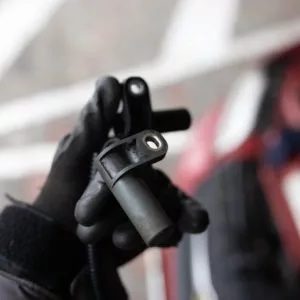Modern vehicles keep track of various parts and systems through sensors like the manifold absolute pressure (MAP) sensor. The MAP sensor delivers critical information to the computer that controls the engine’s performance, so you shouldn’t delay repairing or replacing yours if it has issues.
Your vehicle will not only run less efficiently without the readings from the MAP sensor, but its engine and catalytic converter may also wear out faster. To keep your ride running smoothly for as long as possible, you should avoid driving with a bad MAP sensor unless it’s an emergency.
Can I Drive a Car with a Bad MAP Sensor?
In most cases, you can technically continue to drive with a bad MAP sensor. But that doesn’t mean you should. It’s not a good idea to keep driving your vehicle without replacing its bad MAP sensor first. Your car’s computer or powertrain control module (PCM) relies on the sensor’s readings to determine the right amount of fuel to inject into the engine cylinders.

If the computer adds too much fuel, the engine will run rich. Conversely, if it doesn’t add enough fuel, it will run lean. Since your vehicle’s engine is designed to operate within a certain range, running rich or lean can cause a variety of issues.
A faulty MAP sensor can lead to a wide range of engine performance problems and may even cause your vehicle to stall. What’s more, a faulty MAP sensor can potentially damage other parts of the vehicle.
Once you confirm that your vehicle’s MAP sensor isn’t working as it should, take your vehicle to a trusted auto repair shop. If you have plenty of experience with DIY auto repair, you can order an affordable yet high-quality replacement MAP sensor and install it yourself to save on labor costs.
If you are forced to drive before you can replace its faulty MAP sensor, avoid driving for long periods or over long distances. The longer the engine runs rich or lean, the greater the risk of damaging the vehicle.
In short, driving with a bad MAP sensor should be considered a last-ditch resort.
What Is a MAP Sensor?

Usually located in the upper engine bay, the MAP sensor constantly measures intake manifold pressure and sends the data to your vehicle’s PCM. The computer determines engine load based on the readings from the MAP sensor. Depending on the vehicle, the PCM may use that information when calculating fuel delivery, spark timing, and other operating parameters.
For a more technical understanding of the purpose of the MAP sensor, read our advanced discussion about intake manifold pressure.
What Happens When the MAP Sensor Goes Bad?
Your vehicle’s PCM uses the readings from the MAP sensor to determine engine load. If the sensor sends the wrong information or stops working altogether, the computer may set the wrong air-fuel ratio. This can lead to either the engine running rich or running lean, both of which are bad for your ride in different ways. A faulty MAP sensor may also affect ignition timing, exhaust gas recirculation (EGR) operation, and other operating parameters.
As a result, a faulty MAP sensor can lead to a variety of engine performance problems, such as misfiring, rough running, and stalling. A bad MAP sensor will also likely turn on the check engine light. If you continue to drive the vehicle with a failed MAP sensor, you risk damaging other parts of the vehicle, as well.

Common Causes of a Bad MAP Sensor
The MAP sensor can wear out faster than its expected service life. The engine produces both heat and vibrations that can disrupt or damage the sensor’s internal circuits.
An elastic hose hooks up the MAP sensor to the intake manifold. While it’s made of sturdy materials, the hose can degrade due to the engine bay’s harsh conditions to the point of cracking. Since such a fracture lets manifold vacuum out of the hose, it will change the air pressure and reduce the accuracy of any readings. Vibrations can also loosen the hose’s connection to the sensor, resulting in the same problem.
Contaminants like dirt and engine oil can also disable a MAP sensor. They can interfere with the sensor’s access to the intake manifold by clogging up the connecting hose. Without any way to measure the airflow inside the manifold, the sensor becomes blind and useless.
Another possible reason for MAP sensor-related malfunctions is a vacuum chamber leak. The sensor has a vacuum chamber that provides a baseline of comparison with the air pressure inside the intake manifold. When this chamber leaks, its air pressure changes, making it much less accurate.
What Are the Symptoms of a Bad MAP Sensor?
There are several warning signs to look out for when it comes to an aging or broken MAP sensor. Some of these symptoms include:

- Activated check engine light
- PCM logging an OBD code associated with a bad MAP sensor
- Engine running rich or lean
- Performance problems, such as misfiring, rough running, and stalling
- Failed an emission test
These symptoms are not limited to faulty MAP sensors. If you plan to diagnose your vehicle, check the other parts of the engine and exhaust system until you can positively identify the exact part that failed.
Conclusion
To summarize, don’t ignore a faulty MAP sensor. Replace it as soon as possible and avoid driving your car until the new part arrives.
Where to Get a New MAP Sensor for Your Vehicle
Failing to replace a faulty MAP sensor can contribute to engine performance problems. So when it’s time to get yours replaced, head to CarParts.com and shop from our wide array of high-quality sensors.
Who wants to waste time driving between stores when you can order the parts you need from the comfort of your home? Our user-friendly website has a built-in vehicle selector that lets you filter your options to products compatible with your vehicle specifications.
Need parts for urgent repairs? We ship orders from strategically located distribution centers to ensure fast and efficient shipping. Expect your package to arrive in as quick as two business days.
Don’t delay replacing your faulty MAP sensor. Shop now, and get the best deals today!
Any information provided on this Website is for informational purposes only and is not intended to replace consultation with a professional mechanic. The accuracy and timeliness of the information may change from the time of publication.





























Good evening i have citi golf 2008 model now it stands at 318800kms , now it starts developing problems one day it was powerles and rev counter just moving up and down when i’ m stopped or just stop idling all this happens when the engine is hot
I took it to the mechanics to diagnose ti see what is the problem computer pick up pressure sensor & map sensor is i replaced both thought that it will not do it again but problem still exists some time it’s jercking as if something is not enough whether its fuel
I would be so great if i can get a solution on this because l love citi golf
Hello,
What were the code numbers that were stored?